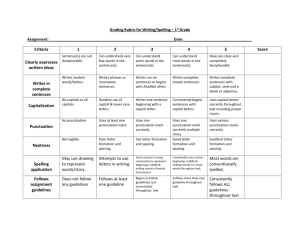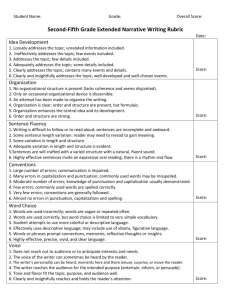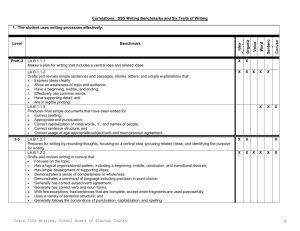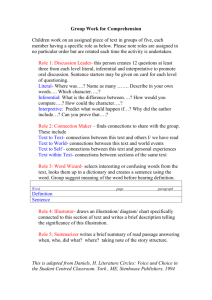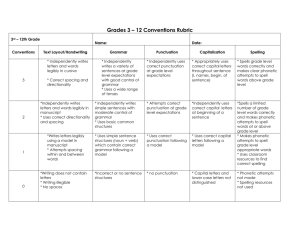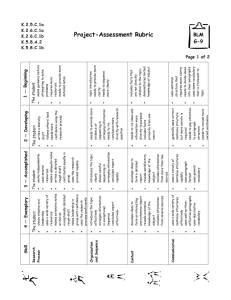Writing - Kindergarten
advertisement
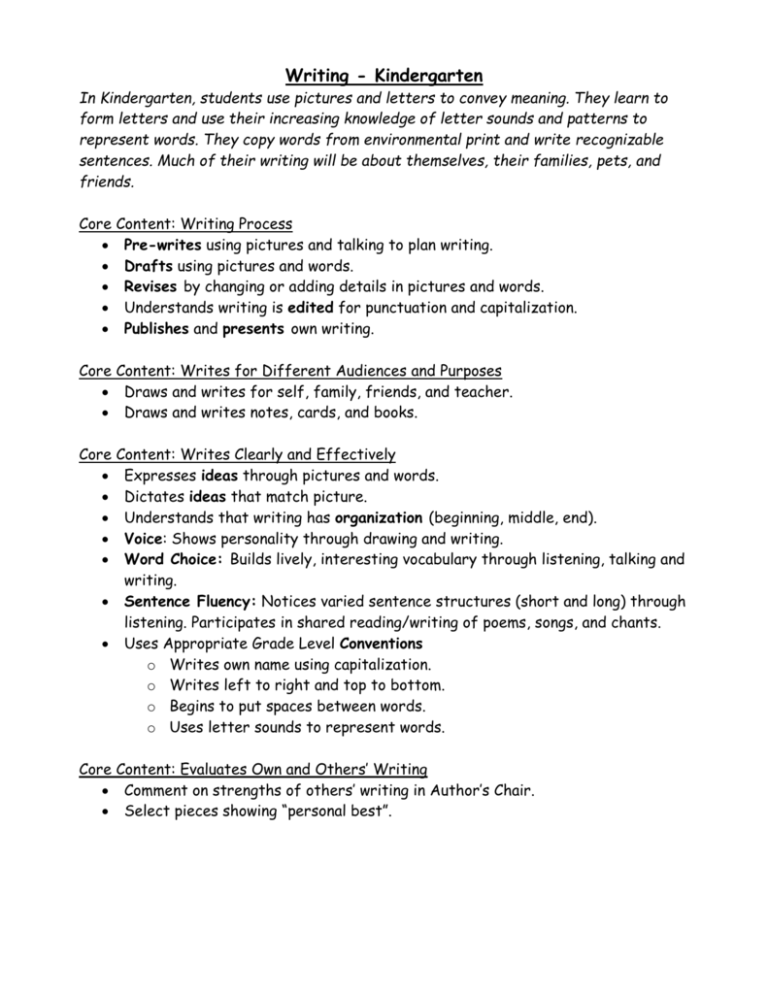
Writing - Kindergarten In Kindergarten, students use pictures and letters to convey meaning. They learn to form letters and use their increasing knowledge of letter sounds and patterns to represent words. They copy words from environmental print and write recognizable sentences. Much of their writing will be about themselves, their families, pets, and friends. Core Content: Writing Process Pre-writes using pictures and talking to plan writing. Drafts using pictures and words. Revises by changing or adding details in pictures and words. Understands writing is edited for punctuation and capitalization. Publishes and presents own writing. Core Content: Writes for Different Audiences and Purposes Draws and writes for self, family, friends, and teacher. Draws and writes notes, cards, and books. Core Content: Writes Clearly and Effectively Expresses ideas through pictures and words. Dictates ideas that match picture. Understands that writing has organization (beginning, middle, end). Voice: Shows personality through drawing and writing. Word Choice: Builds lively, interesting vocabulary through listening, talking and writing. Sentence Fluency: Notices varied sentence structures (short and long) through listening. Participates in shared reading/writing of poems, songs, and chants. Uses Appropriate Grade Level Conventions o Writes own name using capitalization. o Writes left to right and top to bottom. o Begins to put spaces between words. o Uses letter sounds to represent words. Core Content: Evaluates Own and Others’ Writing Comment on strengths of others’ writing in Author’s Chair. Select pieces showing “personal best”. Writing - First Grade In first grade, students are able to develop an idea beyond one sentence, adding details. Students use some prewriting strategies with support from the teacher. Although phonetic spelling is common, more words are spelled correctly, with an awareness of word family patterns. As understanding of revising and editing develop, students reread what they write and make changes to improve their writing. Conventions of directionality, spacing, capitalization, punctuation, and letter formation ensure writing is understandable to the reader. Core Content: Writing Process Pre-writes using talking, pictures, and words to plan writing. Drafts using a plan from pre-writing using more than one sentence. Revises after re-reading or responding to questions from teacher and peers. Adds more details or changes text to enhance writing. Edits for punctuation, capitalization, and correct spelling of grade level sight words. Publishes and presents own writing. Core Content: Writes for Different Audiences and Purposes Writes for self, family, friends, and teacher. Writes to express (stories and poems), inform (how-to books and reports), record (science journals and math data), communicate (notes and cards) and respond (literature response projects). Core Content: Writes Clearly and Effectively (6 Traits) Expresses and develops ideas using multiple sentences. Elaborates on ideas using descriptive words and phrases. Organizes multiple sentences on one topic showing beginning, middle, and end. Voice: Shows personality through drawing and writing (exclamation points, size and shape of words). Word Choice: Uses lively, interesting vocabulary in writing (color, sensory, size words). Sentence Fluency: Uses varied sentence structures (short and long). Participates in shared reading/writing of poems, songs, and chants. Uses appropriate grade level Conventions: o Uses spaces between words and sentences. o Capitalizes first word in a sentence and proper nouns. o Uses end punctuation. o Spells phonetically using vowels and word family patterns. o Spells grade level sight words correctly. Core Content: Evaluates Own and Others’ Writing Comment on strengths of others’ writing in Author’s Chair. Select pieces showing “personal best”. Writing - Second Grade In second grade, students make significant progress as they move from simple to more complex writing, often including sequential events. Students plan their writing purposefully, work towards accuracy, and make conscious word choices. Sentence structures are varied. Students reread their work and revise to improve their writing. Students write in a variety of forms using the basic conventions of writing. Core Content: Writing Process Pre-writes using talking to generate ideas and graphic organizers (story maps, webs, and lists) to plan writing. Drafts using a plan from pre-writing using multiple sentences. Revises after re-reading or responding to questions from teacher and peers. Adds more details or changes text to clarify meaning and enhance writing. Edits for punctuation, capitalization, and correct spelling of grade level sight words using personal dictionaries and checklists. Publishes and presents own writing. Core Content: Writes for Different Audiences and Purposes Writes for self, family, friends, and teacher. Writes to express (stories and poems), inform (instructions and reports), record (science journals and math data), communicate (letters and cards) and respond (literature response projects). Core Content: Writes Clearly and Effectively (6 Traits) Expresses and develops ideas using multiple sentences. Elaborates on ideas using descriptive words and phrases. Organizes multiple sentences on one topic showing beginning, middle, and end. Uses transitional words frequently (next, first, and after). Voice: Shows personality through drawing and writing (exclamation points, size and shape of words). Word Choice: Uses lively, interesting vocabulary in writing (color, sensory, size words). Uses classroom resources such as personal dictionaries and word walls. Sentence Fluency: Uses varied sentence structures (short and long). Uses varied sentence beginnings. Participates in shared reading/writing of poems, songs, and chants. Uses appropriate grade level Conventions: o Uses legible handwriting. o Applies capitalization rules. o Uses punctuation including end marks, commas, quotations, and apostrophes. o Identifies misspelled words and uses spelling resources to correct them. o Spells grade level sight words correctly. Core Content: Evaluates Own and Others’ Writing Comment on strengths of others’ writing in Author’s Chair. Select pieces showing “personal best”. Evaluates own writing using the 6 Traits. Writing - Third Grade Third grade students write longer texts, especially narratives. They embed their ideas in time and place and develop characters through detail and dialogue. Students organize around a central idea and elaborate using complete sentences. Information gathering is common as part of the planning process. Students become more selective about vocabulary, especially when writing informational texts. Students listen to others’ writing and offer feedback and begin to consider suggestions from others about their own writing. Core Content: Writing Process Pre-writes by talking to rehearse writing and using webs, lists and drawings Drafts multiple paragraphs over time Revises to improve text: rereads, adds, deletes, substitutes, moves words and confers with teachers and peers Edits for grade level conventions and 6 Traits Publishes text to share with an audience Core Content: Writes in a Variety of Forms for Different Audiences and Purposes Changes writing for different audiences Identifies different purposes in writing Uses a variety of forms and genres: poetry, letters, fiction, narrative, essays Core Content: Writes Clearly and Effectively Generates ideas, selects topics, adds details and elaborates Organizes by writing beginnings, middles and endings; writes sequentially Includes a problem and solution in a story Writes with appropriate style: voice, word choice, sentence fluency (type and structure) Uses writing conventions by applying rules for: spelling, capitalization, punctuation and word usage Uses legible cursive handwriting Writes a paragraph using complete and varied sentences Core Content: Evaluates Writing Uses established criteria to evaluate writing (e.g., checklists that focus on: details, word choice, organization, voice, content and conventions) Explains strengths and weaknesses of own writing Selects work for a portfolio Sets goals for improvement Writing - Fourth Grade Fourth grade students write for a range of purposes, including describing, telling a story, and explaining. They are able to produce writing that goes beyond the formulaic. They become aware of the interdependence of topic, audience, purpose, and form. Their understanding and use of figurative language introduces imagery to their writing. Informational writing reflects understanding of specific purpose, often requiring gathering and synthesizing information from a number of resources to express and justify an opinion. Students are more aware of the conventions of writing as they reflect on their strengths and weaknesses and strive to improve. Core Content: Writing Process Pre-writes by talking to rehearse writing, uses webs & graphic organizers to narrow the topic and gathers information from more than one source to synthesize ideas and content. Produces a draft of multiple paragraphs over time. Revises to improve text: rereads, adds, deletes, substitutes, moves text and confers with teachers and peers. Uses more than one resource to revise writing: word walls, dictionaries or thesaurus. Edits for grade level conventions and 6 Traits. Publishes in more than one format to share with an audience. Core Content: Writes in a Variety of Forms for Different Audiences and Purposes Changes writing for different audiences Identifies different purposes in writing: personal narrative, essay and fiction writing Produces a variety of new forms and genres: science logs, book report, letters Core Content: Writes Clearly and Effectively Generates ideas and content, narrows the topic, elaborates using specific details or examples Organizes paragraphs logically Constructs a recognizable introduction and conclusion Organizes plot structures using problem-solution-outcome Uses appropriate voice for different audiences and purposes Uses writing conventions by applying rules for: spelling, capitalization, punctuation and word usage Uses legible handwriting: cursive or printing Uses complete, varied sentence structures and paragraph conventions Core Content: Evaluates Writing Uses WASL rubric, anchor papers, checklists and 6-Trait scoring guides to evaluate writing Explains strengths and weaknesses of own writing Selects work for a portfolio Sets goals for improvement Writing - Fifth Grade Fifth grade students develop a strong personal voice in their writing. They sometimes inject humor and emphasis or opinion into their writing. Students use precise, specialized vocabulary appropriately in content-area writing. They experiment with sentence length and complex sentence structures and varied leads and endings. Collaborative writing efforts are taken seriously, often with assigned responsibilities and checklists. Scoring guides provide criteria for critiquing their own work and that of others. Core Content: Writing Process Pre-writes by talking to rehearse writing, uses webs & graphic organizers to narrow the topic and gathers information from more than one source to synthesize ideas. Produces multiple drafts of multiple paragraphs over time. Revises to improve text: rereads, adds, deletes, substitutes, moves text and confers with teachers and peers to get feedback. Revises using more than one resource: writing guide, computer, thesaurus Edits/proofreads to identify and correct errors on conventions and 6 Traits. Publishes multipage pieces in more than one format to share Core Content: Writes in a Variety of Forms for Different Audiences and Purposes Adapts writing for different audiences and identifies different purposes for writing: personal narrative, essay and fiction writing Writes to analyze and learn from informational texts: e.g., explain steps of scientific investigation Produces a variety of new forms and genres: e.g., interviews, persuasive advertisements, field observation notes and business letters Core Content: Writes Clearly and Effectively (6 Traits) Generates ideas, narrows the topic, elaborates using specific details, examples, personal experiences, observations and research to support opinions Writes in a logically organized progression of paragraphs Writes varied leads and endings in narratives Organizes clearly: compares, explains, persuades, and narrates Uses appropriate voice and precise language (word choice) for different audiences and purposes: literary and sound devises such as similes, personification Uses writing conventions by applying rules for: spelling, capitalization, punctuation and word usage Uses legible handwriting; cursive or printing Uses a variety of sentences (sentence fluency): lengths, beginnings, structures and writes in paragraph form Core Content: Evaluates Writing Uses WASL rubric, anchor papers, checklists and 6-Trait scoring guides to evaluate writing Explains strengths and weaknesses of own writing, selects work for a portfolio and sets goals for improvement
